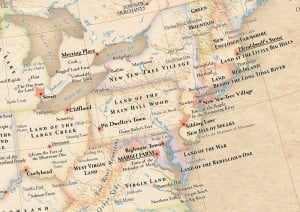The Atlas of True Names: the etymology of place names
Source: kalimedia.com
For those interested in etymology (the study of where words come from), this is a fantastic resource. At first glance it may look like a standard atlas, but take a closer look at the names of places and you’ll see that the map doesn’t show the modern-day names, but the modern English translation of where the name came from. For example, San Francisco is marked “St. Little Frank One”, New York is “New Yew Tree Village”, Philadelphia is “Sibling Love”, and so on.
Some places have more obvious etymology than others (for example Vermont means “Green Mountain”, easily decipherable for anybody who has ever learned French), but some etymologies are truly fascinating.
The study of where places got their names from is known as toponymic etymology. The site gives some further insight into how most places got their names:
Many geographical names are clearly rooted in Man’s observation of his natural environment; the physical location of a settlement: “At the Foot of the Mountain” – Piedmont, the character of an important water course: “The Gentle One” – The Seine, or even just the local vegetation: “Under the Oaks” – Potsdam.
Unsurprisingly, countries and landscapes often derive their names from the characteristics of the people who lived there: “Great Land of the Tattooed” – Great Britain, whilst local mythology and regional rulers also frequently leave their legacy: “Isle of the Monster’s Eye” – Peleponnese, or “Illustrious Emperor” – Zaragoza.
If you’re interested in finding out more about the origins of countries, regions and cities, you can order separate fold-out maps of the USA, Europe or the UK for £4.99 (around $7.50) directly from the site, or a wall poster of the world or the USA for £14.99 (around $23).
